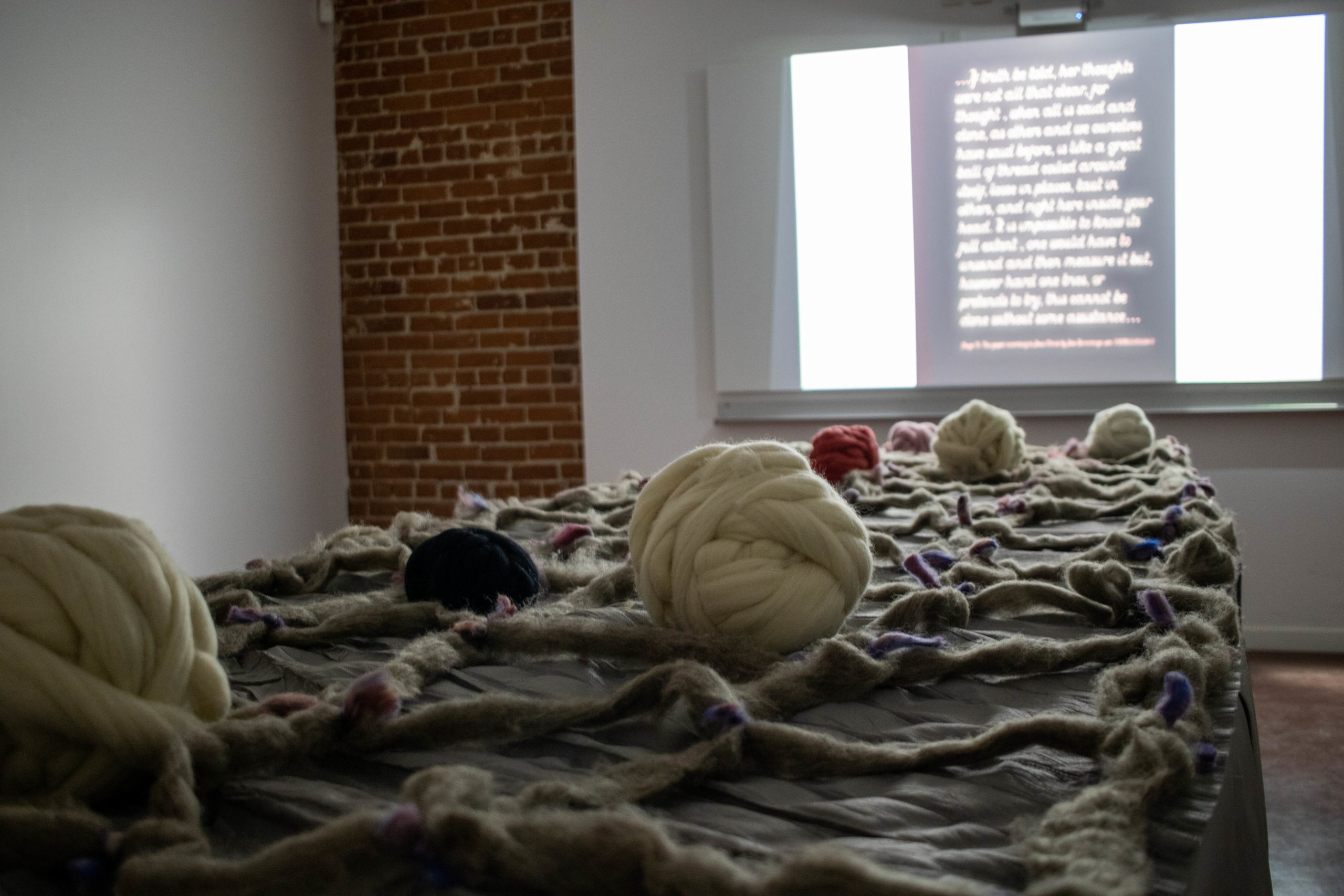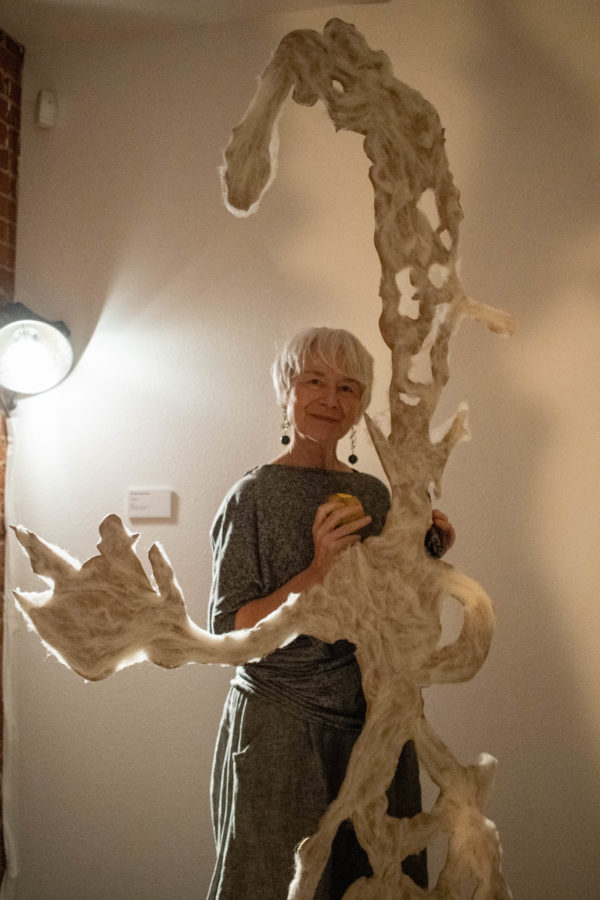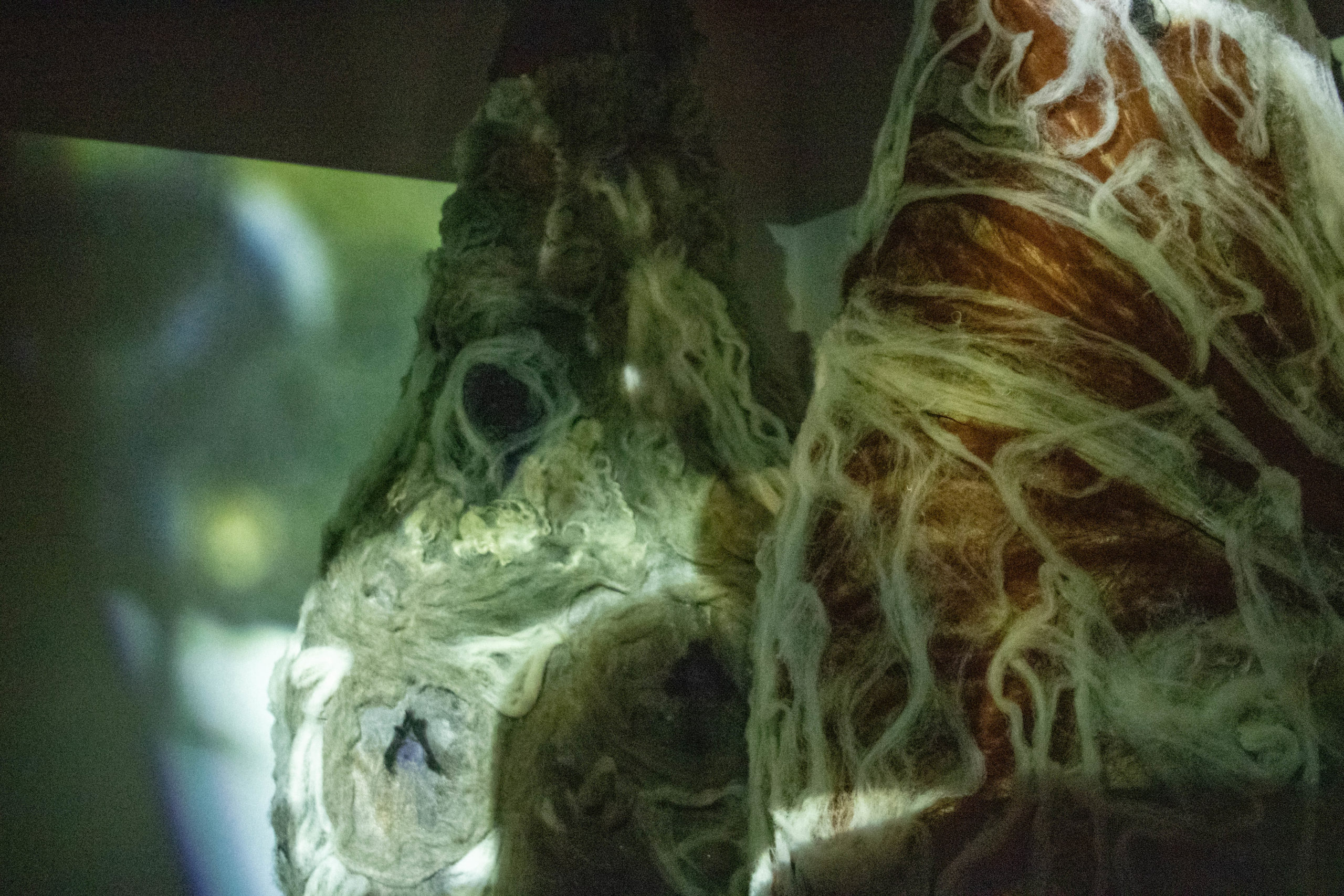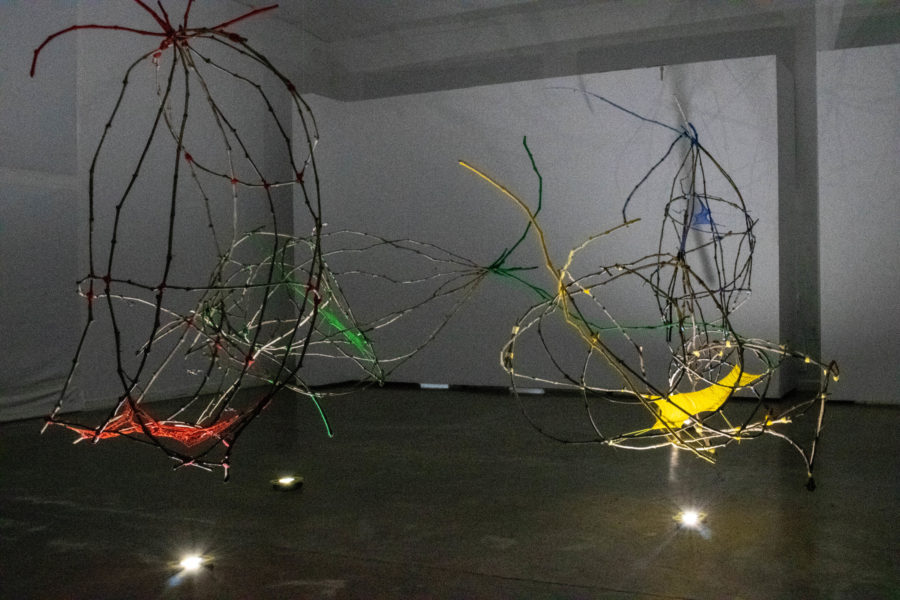The fates bring Dutch artist to the Central Valley
“A Patch Went on A Journey” is the title piece for the show. It utilizes a phone that displays the deconstruction of the blanket made by Bouwmans’ mother. (Sarah Delgado/The Collegian)
Apr 18, 2023
This story was updated April 21, 2023 at 4:06 p.m.
Before Marijke Bouwmans turned 10, her mother was planning to desert her, her siblings and her husband, cycling away for several hours until she changed her mind at the last moment. Although her mother decided to return, Bouwmans on that day wished she had continued pedaling the other direction.
As an adult, Bouwmans realized that her mother in that moment was not a positive role model for deciding to stay in her marriage.
Her mother’s emotions during that moment of her life were an inspiration for one of the works in most recent art exhibition.
On April 6, Graduate Art Studios on M Street hosted “A Patch Went on A Journey,” highlighting works of Fresno State graduate students.
Bouwmans is a guest professor at Fresno State who teaches graduate students how to create installation art.
She always wondered what would happen if her mother didn’t stay, and those kinds of questions are what she focuses on in her installation art, with the theme based on fate and destiny.
One of the highlights of Bouwmans’ exhibition is a sculpture piece called the “The Matrixicals.” It is constructed from grapevines of local farmers, telling a story of bonding and reconnection. Two of those sculptures are estranged and embedded in a web of crocheted designs contributed by Bouwmans’ sisters.
She said her piece is to provoke the unanswerable questions in life.
“Where do you stop? Where do you go forward? Where do you have courage? Or what is it that you need to do when you get stopped to move forward,” Bouwmans said.
As a psychotherapist and traveling artist, Bouwmans is often faced with fate. Her psychotherapist side analyzes the deeper meaning of the subconscious. As a resident from North Fork, to Fresno and back to the Netherlands, her art can face some difficulties as it travels with her.
Bouwmans spends six months in the U.S. and six months in the Netherlands each year. She is a psychotherapist and an artist. Her art began with painting, and ultimately evolved into the very physical form of sculpture and installation.
When building “The Matrixicalses,” Bouwmans’ original idea involved having the sculptures be navigated through the use of engineered bases. Bouwmans collaborated with two Turkish engineers to have the artworks roll around the space on robotic bases, but by the time the bases had reached the U.S., they fell apart.
“Basically, they were programmed such that they had to find their own way of relating to each other. So they will be just buzzing around here and say ‘Oh, I need to make a left turn’ or ‘I’m stuck and I need to back up,’” she said.
Bouwmans thought of this in a psychological way, her first reaction being that the broken parts meant that it would potentially be a reason to cut the show altogether.
Just two days before the show, Bouwmans worked closely with Chris Lopez, multimedia artist and Fresno State gallery technician, to make the exhibition work despite the technical complications.
Alongside Lopez and Bouwmans, students contributed their own works to the exhibition, forming an ecosystem of emotion.
“They [the community] first and foremost see the work of Marijke and understand her concepts and where she was going and maybe be inspired by her,” Lopez said. “I hope our students who attended the show and participated in this show are inspired by her.”
For the title work, “A Patch Went on A Journey,” Bouwmans incorporates the idea of her mother again.
When her mother had reached old age, Bouwmans’ sister had given their mother material to knit to keep her busy. Eventually, the project had transformed into a quilt, one Bouwmans would tear apart for her project.
The installation became a tower of stacked square patches with a box constructed by Craig Hasegawa that included a phone displaying the video that gives viewers a small behind-the-scenes glimpse of the quilt deconstruction. Tiles, made from latex and paint, lined the wall to replicate her mother’s knitted pattern.
“It’s her life’s journey, if you wish, this is the title of the show,” she said. “It’s like the humbleness of life, like I’m just a little patch. I’m just doing a little thing in life.”
But Bouwmans has had an extensive journey, one that details a life well lived.
She began her journey as a school teacher, then vacationed in Greece to fall in love with a man from Fresno while there, and began a new life in California. Only then did she become a psychotherapist after taking a psychology class in college during her pursuit for a teaching degree.
Just along the tower are stray threads hanging from one another. Bouwmans said this represents growth.
“A patch is never finished. If you look at yourself as like, ‘I’m just a little patch,’ you know, I need to grow up or I need to grow bigger,” Bouwmans said. “It’s a process that is never done.”
After the feelings of uncertainty, viewers are introduced to a room that shines a glimmer of hope. It explores the emotion of feeling supported and explains unity.

“The Table of Content” features a projector with a passage from Jose Saramago’s novel “The Gospel According to Jesus Christ” and features solemn music from Phillip Glass.
In “The Table of Content,” the display features interconnected wool manipulated into a grid with naturally dyed balls of yarn placed in between the blank spaces.
“It’s like thoughts are a great ball of thread, you know, coiled around itself loose in places and taunt in others and so that it lives in your head. And it’s impossible to know what you think,” she said, reading a quotation from Saramago.
The artwork that became sprawled out against the gray sheet became a direct embodiment of people needing one another. The wool was provided by a friend of Bouwmans’ in North Fork.
“Even if you try hard, or if you pretend to try, what you all think it says, it cannot be done without some assistance. That comes back to the whole piece of that. I think that we really need each other to make the world matter,” Bouwmans said.
It correlates with how Lopez and Bouwmans needed to work together to pull the exhibition off; despite Bouwmans almost shutting it down.
In the main room, guests are greeted lay a wool structure and enigmatic figures made of cut canvases. The untitled wool structure was made in collaboration with Angel Lesinkowski, a Fresno State graduate student.
The three fates, named “Clotho,” “Lachesis” and “Atropos,” are Greek entities that determine fates.

In conjunction with Bouwmans’ psychotherapist profession, she said that in her analyses of patients, she often asks of their dreams, an echo of their subconscious.
For Bouwmans, whenever she would conduct an inkblot test, she would often see the repetition of the three figures in her work. The Greek figures all represent aspects of milestones in one’s life.
“Clotho,” one of the three fates, is responsible for starting a person’s life. “Lachesis” measures the length of an individual life. Ultimately, “Atropos” was responsible for ending one’s life after their duration had been reached.
Bouwmans connected this with the concept of the American dream.
“So it’s a whole deterministic way of thinking about agency, that it is sort of determined for you, [and] how far you can get in life, versus the American dream,” she said.
Bouwmans analyzes this from an artistic perspective: how to make it as an artist and how society may treat your artwork.
“If I may be a little bit critical of American culture and capitalistic culture, then this is more of a deterministic view of agency. So if you look at it, we have a sort of a different thought about how creative agency works in retrospect,” she said.
The fate of the American dream was something graduate student Eduardo Fabian incorporated in his installation art.
Under the guidance of Bouwmans, Fabian constructed two wool covered cardboard cocoons. The piece titled “Hope and Despair,” or “Los Capullos,” is a depiction of the fortunate and unfortunate fates.
“With this opportunity with the professor, Marijke, it was something she proposed we do and that is when I saw an opportunity to build something different than what I usually do, which is ceramics,” Fabian said.
The healthy cocoon depicts monarch butterflies and happiness, while the other cocoon depicts demons and the state of purgatory, which came directly after news of the migrant deaths near Juarez.
The film “Los Migrantes En El Camino” plays against the two cocoons, extensively detailing the the journeys immigrants go through to find new life in America.
“In the past, we have never seen anything like this. To see millions of people leave their home countries to go to a destination where they are not welcomed, it’s something really meaningful,” he said.
It’s why the cocoons and monarch butterflies coincide with the immigrants, as monarch butterflies are viewed as vulnerable and often travel great distances in search of better living conditions.
But vulnerability was the last thing Fabian wanted to use to describe the journey of immigrants.
“I don’t want to cause people to feel hurt over immigrants. In contrast, I want them to see how these people are very strong-willed when they are faced with the situation of leaving their home countries for the better decision in regards to their family,” he said.
Fabian, who was born in Mexico and is a father of three, had many trials to face when he arrived. He said he had to start over in education and had to learn English to progress to higher education. It has been hard because of the cost for education.
He said he thanks Bouwman for bringing the idea to light.

“Marijke helped me focus on the idea for the cocoons. It was a form of hibernation, to be asleep and when the time is right to come out, it’s time to come out to the normal life,” he said. “Immigrants do not have normal lives. Many families can’t enjoy normal things like seeing art because they have other obligations in order to live comfortably.”
“A Patch Went On a Journey” will continue to run until April 22 at Graduate Art Studios on M Street.
Correction April 21, 2023:
In a previous version of this article, the name of the sculpture was misspelled. Bouwmans piece is called “The Matrixicals.”








